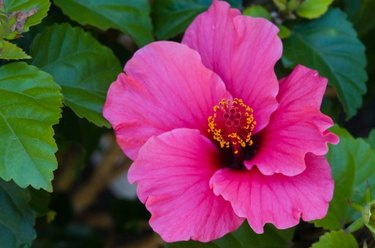
The rose of Sharon (Hibiscus syriacus) is best known for its large, highly ornamental flowers, which come in a range of colors. This plant is also known as the shrub althea. It's hardy in cooler climates than the tropical hibiscus, growing as far north as USDA hardiness zone 5 to zone 9. The rose of Sharon grows either as a small tree or a full shrub, reaching up to 12 feet tall and 10 feet wide.
A popular yard and patio plant, the rose of Sharon is fairly hardy. A little pruning and shaping can go a long way toward maximizing the visual appeal of this plant. The colorful blooms are pretty on their own, but they also attract pollinators such as bees and hummingbirds.
Video of the Day
Video of the Day
Shades of Pink
Brilliant pink is one of the most popular colors for the rose of Sharon. For rosy blossoms, select from cultivars such as the 'Ardens,' which has double blossoms with pinkish-purple petals. Some of the most commonly found cultivars are those released by the United States National Arboretum (USNA), as part of their extensive breeding efforts, and feature advantages such as a lower rate of seedlings forming around the plants from dropped flowers.
Some of the more popular USNA-produced varieties include the 'Minerva,' with pink-lavender flowers and intense red centers, and the highly ruffled 'Aphrodite,' with petals that change from dark pink at their outer edges to deep red in the center. The USNA varieties typically reach heights of around 10 feet tall. For pure pink color, select from the double-blooming 'Leopoldii Plenus' or 'Paeoniflorus' or the double-flowering 'Lucy' (red-pink flowers) or single-flowering 'Rubus' (rose-pink flowers)
White Flower Options
White is another popular color for rose of Sharon flowers, and in this category, there are some truly beautiful options. USNA varieties include the 'Diana,' with pure white flowers, and the heavily ruffled 'Helene,' which has white flowers with red centers. The 'Helene' may have anywhere from three to 20 petals. The 'Red Heart' also produces flowers that are white on the outside and red in the center.
Additional choices include the 'Jeanne d'Arc,' which has double blooms with its two layers of pure white petals. The 'Lady Stanley' has semi-double flowers, fuller than single blooms, that have white petals with red streaks. For a pure white bloom, opt for the 'Totus Albus' or the 'Admiral Dewey.'
Purples and Blues
Those looking for darker colored flowers may find the purple and blue varieties of the rose of Sharon appealing. The 'Bluebird' offers a most unusual delight: a sky blue flower with a touch of deep red concentrated at its center. The 'Boule de Feu' (or 'Ball of Fire') has double blooms with purple-red petals. The 'Coelestis' flowers are single-blooming, violet-blue at the edges and a red-purple color at the center.
For a more lavender shade, you can always opt for 'Coerulis,' a semi-double flower. The 'Souvenir de Charles Breton' also bears semi-double flowers with a lighter shade of purple and the 'Coerulis Plenus' steps things up with double-blooming lavender flowers. The 'Woodbridge' has single, red-purple flowers that gradually go from dark purple, at the throat, to lighter shades at their edges.